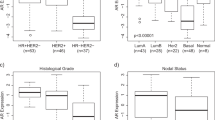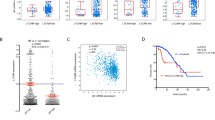Abstract
Background. Using array analysis for screening RNA from BRCA1-mutated and sporadic breast tumors, we observed that AIGF/FGF-8 expression was lost in BRCA1-mutated breast tumors. Since this growth factor is induced by androgens, we studied the androgen receptor (AR) expression in BRCA-mutated tumors and in matched sporadic breast tumors.
Methods. Paraffin embedded breast tumors of carriers of a BRCA1 mutation (n = 41, median age of patients at time of surgery was 41 years [range 28–59 years]) or a BRCA2 mutation (n = 14, median age 41 years [range 31–85 years]) were analyzed for the presence of ER-alpha, PR, P53 and AR using standard immunohistochemical techniques. All statistical tests used, Pearson χ2 and Fisher exact, were two-sided.
Results. The AR was only present in 12% of BRCA1-mutated tumors, with mutations located at the C-terminal half of the BRCA1-gene. The AR expression was significantly more prevalent, however, in a series of 61 sporadic breast tumors (80%) and in BRCA2-mutated tumors (50%). In contrast to an increased percentage of p53 positive cells, in 66% of the BRCA1-mutated tumors, the ER-alpha expression was observed only in 25% and the PR in 13% of these specimens. The three steroid hormone receptors were expressed in about half of the BRCA2-mutated specimens studied.
Conclusions. Our data add to the emerging evidence that the biological phenotype of BRCA1-associated tumors may be different from BRCA2 and non-hereditary cases. The loss of the AR expression, as shown by immunohistochemistry, together with the observed loss of other steroid hormone receptors in BRCA1-mutated tumors may lead to a hormone-independent growth or to anti-hormone resistant growth of these tumors.
Similar content being viewed by others
References
Welcsh PL, King MC: BRCA1 and BRCA2 and the genetics of breast and ovarian cancer. Hum Mol Genet 10: 705–713, 2001
Scully R, Livingston DM: In search of the tumour-suppressor functions of BRCA1 and BRCA2. Nature 408: 429–432, 2000
Berns EM, van Staveren IL, Verhoog L, van de Ouweland AM, Meijer-van Gelder M, Meijers-Heijboer H, Portengen H, Foekens JA, Dorssers LC, Klijn JG: Molecular profiles of BRCA1-mutated and matched sporadic breast tumours: relation with clinico-pathological features. Br J Cancer 85: 538–545, 2001
Tanaka A, Miyamoto K, Minamino N, Takeda M, Sato B, Matsuo H, Matsumoto K: Cloning and characterization of an androgen-induced growth factor essential for the androgendependent growth of mouse mammary carcinoma cells. Proc Natl Acad Sci USA 89: 8928–8932, 1992
Tanaka A, Furuya A, Yamasaki M, Hanai N, Kuriki K, Kamiakito T, Kobayashi Y, Yoshida H, Koike M, Fukayama M: High frequency of fibroblast growth factor (FGF) 8 expression in clinical prostate cancers and breast tissues, immunohistochemically demonstrated by a newly established neutralizing monoclonal antibody against FGF 8. Cancer Res 58: 2053–2056, 1998
Hackenberg R, Schulz KD: Androgen receptor mediated growth control of breast cancer and endometrial cancer modulated by antiandrogen-and androgen-like steroids. J Steroid Biochem Mol Biol 56: 113–117, 1996
Kuenen-Boumeester V, Van der Kwast TH, Claassen CC, Look MP, Liem GS, Klijn JG, Henzen-Logmans SC: The clinical significance of androgen receptors in breast cancer and their relation to histological and cell biological parameters. Eur J Cancer 32: 1560–1565, 1996
Kuenen-Boumeester V, Van der Kwast TH, van Putten WL, Claassen C, van Ooijen B, Henzen-Logmans SC: Immunohistochemical determination of androgen receptors in relation to oestrogen and progesterone receptors in female breast cancer. Int J Cancer 52: 581–584, 1992
Wooster R, Mangion J, Eeles R, Smith S, Dowsett M, Averill D, Barrett-Lee P, Easton DF, Ponder BA, Stratton MR: A germline mutation in the androgen receptor gene in two brothers with breast cancer and Reifenstein syndrome. Nat Genet 2: 132–134, 1992
Giguere Y, Dewailly E, Brisson J, Ayotte P, Laflamme N, Demers A, Forest VI, Dodin S, Robert J, Rousseau F: Short polyglutamine tracts in the androgen receptor are protective against breast cancer in the general population. Cancer Res 61: 5869–5874, 2001
Park JJ, Irvine RA, Buchanan G, Koh SS, Park JM, Tilley WD, Stallcup MR, Press MF, Coetzee GA: Breast cancer susceptibility gene 1 (BRCA1) is a coactivator of the androgen receptor. Cancer Res 60: 5946–5949, 2000
Elston CW, Ellis IO (eds): Systemic Pathology. 3rd edn, The Breast. Vol 13, Churchill Livingstone, 1998
Lea OA, Kvinnsland S, Thorsen T: Improved measurement of androgen receptors in human breast cancer. Cancer Res 49: 7162–7167, 1989
Phillips KA: Immunophenotypic and pathologic differences between BRCA1 and BRCA2 hereditary breast cancers. J Clin Oncol 18: 107S–112S, 2000
Verhoog LC, Brekelmans CT, Seynaeve C, van den Bosch LM, Dahmen G, van Geel AN, Tilanus-Linthorst MM, Bartels CC, Wagner A, van den Ouweland A, Devilee P, Meijers-Heijboer EJ, Klijn JG: Survival and tumour characteristics of breastcancer patients with germline mutations of BRCA1. Lancet 351: 316–321, 1998
Verhoog LC, Brekelmans CT, Seynaeve C, Dahmen G, van Geel AN, Bartels CC, Tilanus-Linthorst MM, Wagner A, Devilee P, Halley DJ, van den Ouweland AM, Meijers-Heijboer EJ, Klijn JG: Survival in hereditary breast cancer associated with germline mutations of BRCA2. J Clin Oncol 17: 3396–3402, 1999
Verhoog LC, Berns EM, Brekelmans CT, Seynaeve C, Meijers-Heijboer EJ, Klijn JG: Prognostic significance of germline BRCA2 mutations in hereditary breast cancer patients. J Clin Oncol 18: 119S–124S, 2000
King MC, Wieand S, Hale K, Lee M, Walsh T, Owens K, Tait J, Ford L, Dunn BK, Costantino J, Wickerham L, Wolmark N, Fisher B: Tamoxifen and breast cancer incidence among women with inherited mutations in BRCA1 and BRCA2: National Surgical Adjuvant Breast and Bowel Project (NSABP-P1) Breast Cancer Prevention Trial. Jama 286: 2251–2256, 2001
Greenblatt MS, Chappuis PO, Bond JP, Hamel N, Foulkes WD: TP53 mutations in breast cancer associated with BRCA1 or BRCA2 germ-line mutations: distinctive spectrum and structural distribution. Cancer Res 61: 4092–4097, 2001
Lakhani SR, Jacquemier J, Sloane JP, Gusterson BA, Anderson TJ, van de Vijver MJ, Farid LM, Venter D, Antoniou A, Storfer-Isser A, Smyth E, Steel CM, Haites N, Scott RJ, Goldgar D, Neuhausen S, Daly PA, Ormiston W, McManus R, Scherneck S, Ponder BA, Ford D, Peto J, Stoppa-Lyonnet D, Easton DF: Multifactorial analysis of differences between sporadic breast cancers and cancers involving BRCA1 and BRCA2 mutations. J Natl Cancer Inst 90: 1138–1145, 1998
Lakhani SR: The pathology of familial breast cancer: morphological aspects. Breast Cancer Res 1: 31–35, 1999
Birrell SN, Hall RE, TilleyWD: Role of the androgen receptor in human breast cancer. J Mammary Gland Biol Neoplasia 3: 95–103, 1998
Goldenberg IS, Waters N, Ravdin RS, Ansfield FJ, Segaloff A: Androgenic therapy for advanced breast cancer in women. A report of the cooperative breast cancer group. Jama 223: 1267–1268, 1973
Szelei J, Jimenez J, Soto AM, Luizzi MF, Sonnenschein C: Androgen-induced inhibition of proliferation in human breast cancer MCF7 cells transfected with androgen receptor. Endocrinology 138: 1406–1412, 1997
Given HF, Radbourne R, Oag H: The androgen receptor exon 1 trinucleotide repeat does not act as a modifier of the age of presentation in breast cancer. Eur J Cancer 36: 533–534, 2000
Spurdle AB, Dite GS, Chen X, Mayne CJ, Southey MC, Batten LE, Chy H, Trute L, McCredie MR, Giles GG, Armes J, Venter DJ, Hopper JL, Chenevix-Trench G: Androgen receptor exon 1 CAG repeat length and breast cancer in women before age forty years. J Natl Cancer Inst 91: 961–966, 1999
Rebbeck TR, Kantoff PW, Krithivas K, Neuhausen S, Blackwood MA, Godwin AK, Daly MB, Narod SA, Garber JE, Lynch HT, Weber BL, Brown M: Modification of BRCA1-associated breast cancer risk by the polymorphic androgenreceptor CAG repeat. Am J Hum Genet 64: 1371–1377, 1999
Hilakivi-Clarke L: Estrogens, BRCA1, and breast cancer. Cancer Res 60: 4993–5001, 2000
Fan S, Ma YX, Wang C, Yuan RQ, Meng Q, Wang JA, Erdos M, Goldberg ID, Webb P, Kushner PJ, Pestell RG, Rosen EM: Role of direct interaction in BRCA1 inhibition of estrogen receptor activity. Oncogene 20: 77–87, 2001
Zheng L, Annab LA, Afshari CA, Lee II WH, Boyer TG: BRCA1 mediates ligand-independent transcriptional repression of the estrogen receptor. Proc Natl Acad Sci USA 98: 9587–9592, 2001
Mattila MM, Ruohola JK, Valve EM, Tasanen MJ, Seppanen JA, Harkonen PL: FGF-8b increases angiogenic capacity and tumor growth of androgen-regulated S115 breast cancer cells. Oncogene 20: 2791–2804, 2001
Author information
Authors and Affiliations
Rights and permissions
About this article
Cite this article
Berns, E.M., Dirkzwager-Kiel, M.J., Kuenen-Boumeester, V. et al. Androgen Pathway Dysregulation in BRCA1-Mutated Breast Tumors. Breast Cancer Res Treat 79, 121–127 (2003). https://doi.org/10.1023/A:1023347409599
Issue Date:
DOI: https://doi.org/10.1023/A:1023347409599




